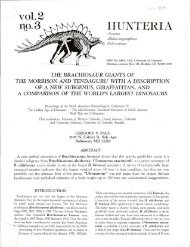THE MANY MYTHS, SOME OLD, SOME NEW, OF ... - Gregory S. Paul
THE MANY MYTHS, SOME OLD, SOME NEW, OF ... - Gregory S. Paul
THE MANY MYTHS, SOME OLD, SOME NEW, OF ... - Gregory S. Paul
You also want an ePaper? Increase the reach of your titles
YUMPU automatically turns print PDFs into web optimized ePapers that Google loves.
DINOSAUR MYTIIS 71<br />
'~ '~<br />
---~~----<br />
, '. \.~<br />
Figure 1 How quadrupedal dinosaurs could leave only their hindprints behind. At top a generalized<br />
iguanodont walks slowly and waddles so the hindfeet fall behind and inside the foreprints (based on<br />
preserved trackways, Currie, 1983; Lockley and Gillette, 1989). In the bottom figure the subject increases<br />
step length a little while decreasing waddling so that tbe hindfeet step onto and obliterate the foreprints.<br />
posture. This has led to a general consensus that dinosaur forelimb action was usually<br />
fully erect (Carpenter, 1982; Currie, 1983; Bakker, 1986, 1987; <strong>Paul</strong>, 1987a; Lockley<br />
and Gillette, 1989; Adams, 1990). A partial exception is found in ornithopods,<br />
whose more laterally open shoulder glenoids, plus some trackways, are compatible<br />
with their occasionally having adopted a less erect arm posture when moving slowly<br />
(alternatively, they were waddling about their hips when making the wide gauged<br />
forefoot trackways). For further details on ceratopsids, see Figure 2.<br />
<strong>THE</strong> FEMORA AND HIND LIMBS <strong>OF</strong> FULLY ERECT ANIMALS WORK<br />
IN A VERTICAL FORE AND AFT PLANE<br />
Myth: Most fore-and-aft view figures of mammal and bird legs show the femora in a<br />
simple vertical posture.<br />
Reality: This is correct only for cats and a few other animals. It is common for knees









